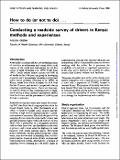Conducting a roadside survey of drivers in Kenya: methods and experiences
Abstract/
Road traffic accidents (RTAs) are the leading cause of mortality in adolescents and young adults in all regions of the world and rank among the top five causes of death (Feachem et al. 1992; World Bank 1993). Traffic-related fatality accounts for 10% of all deaths in the 5-44 year age group in developing countries and is increasingly becoming an important public health problem (Downing et al. 1991). In Kenya, deaths from RTAs increased by 43% over the last 10 years, and alcohol is suspected to be an important contributing factor. There are, however, no specific drink driving countermeasures or legislation setting a blood alcohol concentration (BAC) limit for drivers, and the prevalence of drinking and driving is unknown.
Roadside surveys have been used widely for collecting BAC data from the driving population since the Grand Rapids Study in 1964 (Borkenstein et al. 1964). A standard roadside survey requires specific facilities, a high level of organization and a significant amount of resources. The study design involves sampling drivers from the main traffic stream into specially prepared, highly visible off-road survey sites fitted with a portacabin or a designated research vehicle where interviews and breathtests can be done in privacy, and is most suited for highways in rural locations with ample parking spaces. Permanent police roadblocks, usually placed along inter-urban roads, may also be used as sampling sites, but they present serious biases, in terms of dieir locations and vehicle selection criteria. Alternatively, a method of sampling drivers stopping at a red traffic signal in

